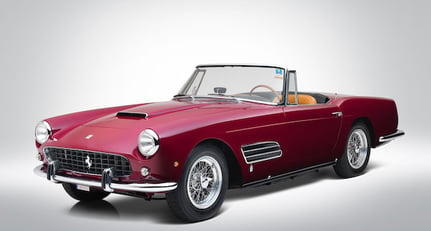1960 Ferrari 250
-
Year of manufacture1960
-
Chassis number2071 GT
-
Engine number2071 GT
-
Lot number28
-
DriveLHD
-
ConditionUsed
-
Number of seats2
-
Location

-
Exterior colourOther
-
Drivetrain2wd
-
Fuel typePetrol
Description
Delivered new to Jean Blaton 'Beurlys' in Belgium via Jacques Swaters' Garage Francorchamps
1960 Ferrari 250 GT Series II Cabriolet
Coachwork by Pininfarina
Chassis no. 2071 GT
Engine no. 2071 GT
By the early 1960s, road car production had ceased to be a sideline for Ferrari and was seen as vitally important to the company's future stability. Thus the 250, Ferrari's first volume-produced model, can be seen as critically important, though production of the first of the line - the 250 Europa, built from 1953 to '54 - amounted to fewer than 20. Before the advent of the Europa, Ferrari had built road-going coupés and convertibles in small numbers, usually to special customer order using a sports-racing chassis as the basis. Ghia and Vignale of Turin and Touring of Milan were responsible for bodying many of these but there was no attempt at standardisation for series production and no two cars were alike.
The introduction of the 250 Europa heralded a significant change in Ferrari's preferred coachbuilder; whereas previously Vignale had been the most popular carrozzeria among Maranello's customers, from now on Pinin Farina (later 'Pininfarina') would be Ferrari's number one choice, bodying no fewer than 48 out of the 53 Europa/Europa GTs built. Pinin Farina's experiments eventually crystallised in a new Ferrari 250 GT road car that was first displayed publicly at the Geneva Salon in March 1956. However, the Torinese Carrozzeria was not yet in a position to cope with the increased workload, resulting in production being entrusted to Carrozzeria Boano after Pinin Farina had completed a handful of prototypes.
The 250 GT featured the lighter and more compact Colombo-designed 3.0-litre V12 in place of its predecessor's bulkier Lampredi unit. Power output of the single-overhead-camshaft all-aluminium engine was 220bhp at 7,000rpm. Shorter in the wheelbase (by 200mm) than that of the Europa, the 250 GT chassis followed Ferrari's established practice, being a multi-tubular frame tied together by oval main tubes, though the independent front suspension now employed coil springs instead of the previous transverse leaf type. A four-speed all-synchromesh gearbox transmitted power to the live rear axle, while braking was looked after by hydraulic drums all round.
True series production began with the arrival of Pininfarina's 'notch back' Coupé on the 250 GT chassis, some 353 of which were built between 1958 and 1960 within the sequence '0841' to '2081'. However, the relatively small scale of production meant that cars could still be ordered with subtle variations according to customer choice, as well as enabling a handful of show cars and 'specials' to be constructed on the 250 GT chassis.
A number of prominent European coachbuilders offered a variety of body styles on the 250 GT chassis, with Scaglietti and Pininfarina producing elegant open-top spyder and cabriolet models. Exhibited at the 1957 Geneva Salon, the latter's first 250 GT Cabriolet, which, unusually, featured a Vintage-style cut-down driver's door, was snapped up by Ferrari works driver Peter Collins, who later had the car converted to disc brakes. After a handful of alternative versions had been built, series production began in July 1957, around 40 Series I Pininfarina Cabriolets being completed before the introduction of the Series II in 1959. Effectively an open-top version of the Pininfarina-built 250 GT Coupé, whose chassis and mechanicals it shared, the Cabriolet was built alongside its closed cousin until 1962. Overall design followed that of the Coupé, with short nose and long rear overhang, while a more-vertical windscreen provided greater headroom in the generously sized cockpit. As well as the aforementioned improvements to brakes and transmission, the Series II cars benefited from the latest, 240bhp V12 with outside sparkplugs, coil valve springs, and 12-port cylinder heads. The 250 GT was the most successful Ferrari of its time, production of all types exceeding 900 units, of which 200 were Series II Cabriolets like that offered here.
A number of important developments occurred during 250 GT production: the original 128C 3.0-litre engine being superseded by the twin-distributor 128D, which in turn was supplanted in 1960 by the outside-plug 128F engine which did away with its predecessor's Siamesed inlets in favour of six separate ports. On the chassis side, four-wheel disc brakes arrived late in 1959 and a four-speeds-plus-overdrive gearbox the following year, the former at last providing the 250 GT with stopping power to match its speed. More refined and practical than any previous road-going Ferrari, yet retaining the sporting heritage of its predecessors, the 250 GT is a landmark model of immense historical significance. Despite this, original survivors are relatively few, as many have been modified and converted into replicas of more exotic Ferraris such as the 250 GTO, Testarossa, etc.
According to the accompanying Massini Report, chassis number '2071' is the 66th of the 200 units built, and as a Series II car has the added advantage of disc brakes all round. Originally finished in the handsome combination of Grigio Argento with Nero interior, the Ferrari was sold new in 1960 via Jacques Swaters' Garage Francorchamps, the official Ferrari importer for Belgium, to its first owner, Jean Blaton. A wealthy Belgian industrialist, Ferrari aficionado and gentleman racing driver, who raced under the name 'Beurlys', Jean Blaton had an excellent taste and was a personal friend of Jacques Swaters, from whom he bought numerous Ferraris over the years.
Blaton is best remembered for his daring exploits in the Le Mans 24-Hour Race in which he drove a succession of Ferraris over a 10-year period between 1958 and 1967, finishing on the podium on nearly every outing. On many occasions he drove his own Ferraris, including a 250 GT MM, 250 GT Testarossa, 250 GT LWB Tour de France, 250 GT SWB, 250 GTO, 250 LM, and 330 P3/P4. He secured his best result at Le Mans in 1963 when he finished 2nd overall with co-driver Langlois van Ophen at the wheel of a Ferrari 250 GTO, winning the GT Class for Swaters' racing team, Écurie Francorchamps.
Jean Blaton was also a friend of Enzo Ferrari, who was only too happy to accommodate his highly regarded customer's special requests. In the case of his 250 GT Cabriolet, Blaton specified that the car should have large side vents in the front wings, similar to those of the Series III 410 Superamerica, which were incorporated by Pinin Farina on Mr Ferrari's instruction. These vents not only make the car appear more sporting, they also serve to break up its lengthy flanks to good effect. Blaton's car, with its special features, was prominently displayed in Ferrari's 1960 yearbook.
In 1964, Blaton sold '2071' to Luigi Chinetti, another gentleman racing driver and sole importer of Ferraris into the USA. The car was then sold to a Mr Gilbertson from Vista, California. Following Mr Gilbertson's death, the Ferrari was acquired from his widow in 1978 by Mr Ken Gerber of San Diego, California, who kept it for the next 32 years. A member of the Ferrari Owners' Club, Mr Gerber enjoyed the car throughout the 1980s, attending various events.
During Mr Gerber's ownership (in 1992-1994) a fastidious restoration was carried out, the precision machining work on the engine and mechanical systems being entrusted to recognised specialist Bob Wallace of Phoenix, Arizona. Original parts were retained wherever possible and the few that were not saveable were either replaced with originals or perfect reproductions. The car was refinished in Rosso Rubino and completed in time for the 1994 International Ferrari Concours in Monterey.
Ken Gerber sold the Ferrari in 2010 and the following year the car moved to the UK having been bought by DK Engineering. The car was sold to Belgium in 2012, since when it has belonged to the current lady owner. Carrying the very suitable registration, '250 GTS', the car has been enjoyed by its owner on numerous occasions and at prestigious events including the Zoute Rally. Now presented in excellent condition after recent cosmetic re-commissioning, it affords the prospect of comfortable open-top cruising in unparalleled style. Possessing links to Belgian and excellent provenance, this unique Ferrari 250 GT Cabriolet is worthy of the closest inspection.
Accompanying documentation consists of the following:
Current Belgian registration papers
Old UK V5 document in the name of DK Engineering
Copy of the Massini Report including delivery notes
Copies of photographs when the car was at Garage Francorchamps (showing the ultra-rare side vents)
Operating instructions
Some copies of photographs from its days in the USA
Sundry invoices for work carried out
Copies of some old US registration papers
Copy of the Ferrari build sheet
Detailed sales leaflet by DK Engineering confirming the car's history and special order


























